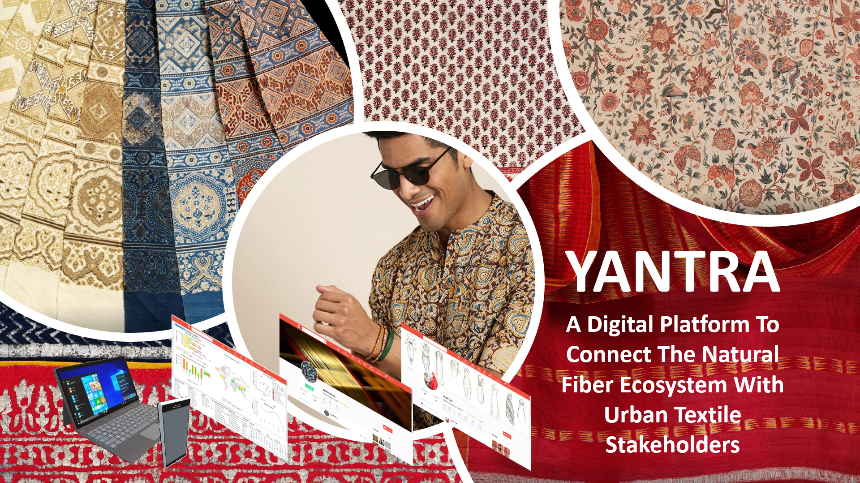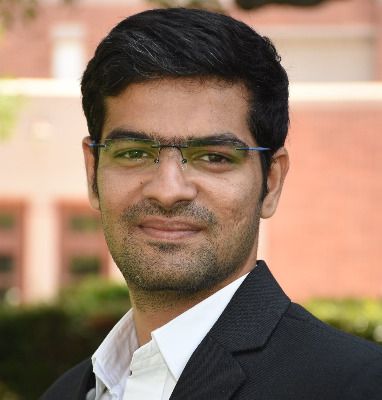YANTRA
Digital Platform to connect the natural fiber ecosystem with urban textile stakeholders. Our mission is to create a scalable ecosystem of businesses around plant-based textiles by satisfying customer needs for sustainable living.

Mission
Create a scalable ecosystem of businesses around plant-based textiles by satisfying customer needs on sustainable living.
Concept
Digital Platform to connect the natural fiber ecosystem with urban textile stakeholders, such as handloom owners, artisans, natural fiber producers, apparel designers, and visual merchandisers.
Concept Summary
Our Digital platform connects stakeholders in the natural fiber ecosystem, such as handloom owners, artisans, natural fiber producers, apparel designers, and visual merchandisers. We expose handloom owners and natural fiber producers to new market segments and a larger stakeholder community where their products' utility can be extracted to the fullest. We provide apparel designers access to largely distributed under digitized handloom weaving communities under a single platform, which helps them address the increasing trend in the current generation towards sustainable living. There is an existing gap in the supply of natural fiber-based textiles; poly fibers capture 80% of market segment.
Who is our customer?
Key customers are in the natural fiber ecosystem, such as handloom owners, artisans, and natural fiber farmers (70Million households across the world), to whom we can provide market intelligence to tailor their products to match consumer needs. Apparel designers from garment companies will get access to a large variety of weaves, patterns, and materials that can be used to target new consumer segments. Additionally, the digital platform can be extended for consumers, influencers, rural development administrators in governments, and fashion schools' faculty and students.
What problem does this idea/product solve or what market need does it serve?
According to Connecom, 94% of Gen Z believe companies should help address social and environmental issues, and 89% of them would buy sustainable products, but there are limited textile alternatives. Textile is the second largest polluter on the planet; micro-poly fibers are increasingly entering the natural ecosystem such as land, water, air, and food. Additionally, textile consumption is expected to increase 500%-1000% in next ten years; with such an increasing textile consumption, mostly aware populations are expected to switch to natural fibers. Current Natural fiber supply chain is decentralized, under-digitized and lacks market intelligence, which we are trying to address.
Description of our technology and how it gives us an advantage to solving the problem described?
We provide an extensible and flexible digital platform to address the variety of needs of our key customers. The human system integration is crucial as major customer segments may not be well versed in handling high-end technological systems. Here we employ automation agents and natural language processing to deal with a variety and scale of customer needs. Humans are key elements of the system. We plan to use human expertise and feedback to deal with and learn from disruptions in the system. Knowledge capture, retrieval, and representation are vital functionalities to enable our customers to better understand the market's needs.
Description of new technology and references.
We plan to use the existing technology for building a digital platform for social communities. The added capabilities related to extensibility, flexibility, and human system integration are developed anew. We referred to a team member's prior works in the systems architecture domain to make important decisions related to the platform's architecture. However, no resources are used from prior work.
Following is the list of literature with links
Next Generation Adaptive Cyber Physical Human Systems
https://apps.dtic.mil/sti/citations/AD1099997
Analyzing Systems Architectures using Inter-Level and Intra-Level Dependency Matrix (I2DM)
https://ieeexplore.ieee.org/document/8913854
Leveraging Digital Twin Technology in Model-Based Systems Engineering
https://www.mdpi.com/2079-8954/7/1/7
Explanation of how we will execute to make this idea/product successful? What gives us (our team) an advantage over others already in the market or new to this market?
We so far interviewed various stakeholders from the natural fiber industry, including apparel designers, farmers, government officials from the national handloom development corporation, and faculty and students from fashion schools. The interviews helped us start with problem definition and initial prototype development. The initial prototype developed has the necessary capabilities of a digital platform. We have research experience in technical business management, system architecture, and Cyber-Physical Human Systems. We have a test database of handloom clusters and weavers. Additionally, our experience of living near the key customer community exposed us to the problems they faced and potential solutions.
What do we think is our team's greatest weakness?
The team lacks the resources and expertise in the textile or fashion design industry. We have limited customer discovery interviews. Information on the specificities of the market is limited. No work experience on the ground; most of the research is based on virtual interaction with stakeholders. The problem statement and detail of the architecture are not clear. We lack the necessary market analysis and knowledge of the possible business model. The current product is in the prototype stage.
What do we most want to improve in the next year?
We plan to refine the problem statement further by conducting interviews. Our objective is to understand the ecosystem better and scope down the capabilities that we provide with our platform. We want to identify the platform's key value propositions and quantify them in terms of our customers' needs. We are also looking for partnership opportunities with local governments from the world's tropical part and gather data. In the upcoming time, we are looking forward to recruiting and increase resources in the team. We are researching potential saboteurs and competitions.
Explanation on IP, If our idea/company is based on an existing IP and how we have access to commercialize it.
The idea is not based on an existing IP. The digital platforms for social communities currently exist. Knowledge capture, retrieval, and representation platforms are in the research phase, but we plan to deploy the platform's advanced versions only in the later stages of the business life cycle. We referred to a team member's prior works in the systems architecture and human system integration domain to make crucial decisions related to the platform's architecture. However, no resources are used from prior work.
Other comments/notes
We believe in attracting major customer segments and partnerships by promoting three societal impacts of our product - 1. Farmers across tropical part of the world are cultivating perishable products heavily dependent on climate conditions and need specific storage capabilities. Creating thriving markets can encourage farmers to cultivate fiber-pants, increasing farmers' income. Move from mass production to production by masses. 2.Avoid degradation of natural ecosystem due to polyfibers and putting large-scale lands under greencover as fibers are produced from plants such as abaca, coir, cotton, flax, hemp, jute, bamboo, banana, nettle, and linen. 3.Save cultures as weaving skills developed over millennia.
Meet the solution owner
